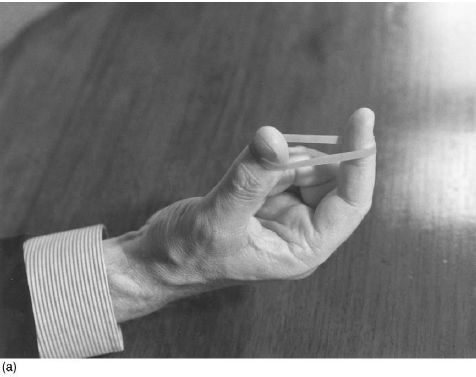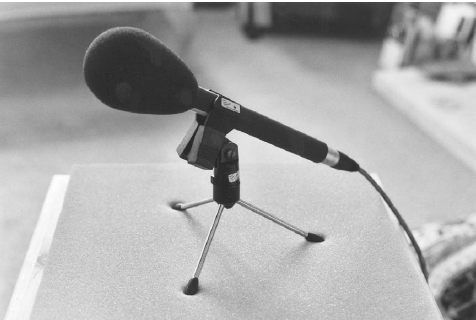1 I'm all ears – theoretically!
There are many aspects to sound and hearing that most of us take for granted. Our ear/brain combination is capable of extremely sophisticated discrimination, enabling us to concentrate selectively on sound from one or two sources within a complex aural background; which may often comprise sound from many sources arriving at our ears simultaneously. Thus, before we start to use a mic, let's delve into some basic sound theory, so that we're aware of why things may not always turn out as expected.
Sound – the executive explanation
Whilst sitting at your desk, pick up an elastic band, and stretch it between the thumb and forefinger of one hand (Figure 1.1(a)–(c)). Whilst watching the band, pluck it with one finger from your other hand – twang – ah, you heard that! And I'm sure you also saw that its vibrations caused the noise.
Well, in a nutshell that's the nature of sound in air. As you ‘pluck’ the elastic band, it vibrates, and the energy thus released pushes the particles (molecules) of air forwards (compression) and backwards (rarefaction) in time with its vibrations. These waves travel through the air, the energy they contain is transmitted to your eardrum, and you hear the ‘twang’.

Figure 1.1 Listen to the band
Furthermore, the closer you hold the band to your ear, the louder it sounds (see also Section 2, Sound measurement; Inverse Square Law), and the ‘harder’ you pluck the band, the louder the sound. The tauter you hold the band, the higher the note you hear, and if you watch closely, you'll see that it vibrates more quickly as it gets tauter. Thus, the frequency of the sound you hear is related to the number of compressions and rarefactions arriving at your eardrum within a fixed time (cycles per second, see also Section 2, Sound measurement; Frequency).
If you're a really top executive, you can carry this experiment to extreme lengths by filling one ear with cotton wool, closing your eyes, and getting your personal assistant to twang the elastic band at differing distances from your unblocked ear. You'll notice that you can easily tell when the twang is close to you, and when it is further away. However, if your assistant also varies the direction, say within a 1808 arc, keeping to the ‘unblocked’ side of your head (so that you definitely can't hear it in your blocked ear) (Figure 1.2), then you'll find it impossible to perceive the direction from which the sound is coming. And that's what you'd expect to find (hear) if you were using a mono microphone in place of your ear!
Home-loving executives, before you bath the kids, once you've filled the bath, pop their plastic duck in the middle, and send a wave rippling out from the side. The duck bobs up and down as the wave passes, but doesn't move along with it. (You may need to pop next door and borrow the neighbours’ if you haven't got your own kids/bath/duck, etc.) The sound wave in air is similar in so far as individual molecules are compressed and rarefied, but stay within the same volume of space, whilst the wave spreads outward from the sound source.

Figure 1.2 As your assistant moves around, you will be unable to determine from which direction the ‘twang’ comes, but you can tell how loud it is, and thus how close it is to you
I hear you knocking
Sound travels faster within solid materials than in air (gaseous transmission) and its transmission through them is often more efficient than through air. If you're in a building when someone starts some serious construction activity – hammering, drilling, etc. – you'll find the sound travels easily throughout the building, penetrating every nook and cranny, and the sound no longer appears to come from a point source. This can make it difficult to locate the source, but rendering any serious sound recording out of the question until you do so.
As an aside, I once undertook a recce on a Friday for a musical item to be recorded in the hall of a municipal building on the following day. It was extremely busy with many staff going backwards and forwards to their offices in the building, as well as members of the public making enquiries, etc. Nevertheless, we were assured that we'd have the hall to ourselves the following day. I even asked if they were expecting public access at any time during the day, but we were assured that the building was officially closed. Imagine our horror on arrival the following morning to find a team of decorators hard at work in the offices adjoining the hall!
So, on location you must be careful to avoid picking up noise or vibration transmitted through the floor when using a stand mic. Wooden floors are a real menace, as the simple act of walking across the floor can easily be picked up by a stand mic anywhere within the room. If there is a danger of this happening, the stand needs to be ‘acoustically isolated’ from the floor to minimize the disturbance, using some form of absorbent material – thick foam/sponge rubber (Figure 1.3), for example – even though the stand base may have rubber feet. The same often applies to a table stand, as any material being knocked or banged on the table will be transmitted – extremely efficiently – to the mic.
Hearing test
Before proceeding further, and attempting to turn this theory into practice, I would advise you to consider having your own hearing tested. I say this because, when I joined the BBC many years ago, part of the first training course I embarked upon had a form of ‘do-it-yourself testing’ for frequency perception in the shape of a variable oscillator. Of course, it was actually intended for checking the frequency response of various items of sound circuitry and equipment, not for the amusement of the great unwashed trainees in our group!
But ever eager to find out what else we could do with the technical equipment at our disposal, we rigged it up to a loudspeaker and turned the dial backwards and forwards, listening to the tone rising and falling in pitch. Through participating in this exercise I discovered that my hearing tailed off around 17 kHz, and that everyone else in our group could hear way above that frequency (most people can hear up to at least 20 kHz). Unfortunately, the loudspeaker was too small to accurately reproduce any bass tones below 40 or 50 Hz, and so we were unable to ascertain what the bottom end of our individual responses might have been.

Figure 1.3 Foam or rubber under a stand can provide greater acoustic isolation, but do ensure that the stand is stable in its position
More recently, my daughter started to complain about her own hearing, and that many of the sounds she heard were often causing her considerable pain. A test subsequently revealed that she had extremely sensitive hearing, and that not only could some levels of sound be painful to her but also that she could perceive frequencies up to 24 kHz (she was forever complaining about our whistling television!). To complete the family picture, I should add that my wife has the opposite problem, being extremely hard of hearing, and often experiences difficulty with the intelligibility of sound on both radio and television, especially if there is any other noise present in the vicinity.
The point of these observations is to indicate the possibility that you may have a deficiency in your own hearing of which you are totally unaware. And if you intend to embark on a career involving sound recording, you should certainly make yourself aware of any limitations in your hearing before you proceed further. Many people find that one of their ears is more sensitive than the other, and that neither ear has exactly the same frequency response. Of course, once you know about any such discrepancies, you can make allowances within your working environment. Looking to the future, I would also advise you to have your hearing checked on a regular basis, say every couple of years, especially if you are in anyway ‘outside the norm’.
As you are probably aware, human hearing deteriorates with age, and the longer you live, the more you're likely to lose both sensitivity and frequency response at the top of the range (not that that's a reason to stop breathing just yet, of course!).
In sickness and in health
In a similar vein, you must be careful if you're unfortunate enough to experience any illnesses which affect your hearing. The common cold is the most likely culprit for this unpleasant experience amongst the community in general, and it really is best to have time off work than jeopardize both a shoot and your hearing. Trying to persist with some type of restriction in your hearing may lead you into monitoring sound at too high a level, and thus worsen your condition, if not leading to a degree of permanent hearing loss.
Without wishing to appear alarmist, there are some exceptionally nasty diseases around the world which can affect your hearing, and I can only recommend you seek medical advice at the first sign of any irritation, inflammation or blockage should you notice or experience one of these afflictions. Better a reputation as a hypochondriac than subsequently being unable to pursue your chosen career path.

